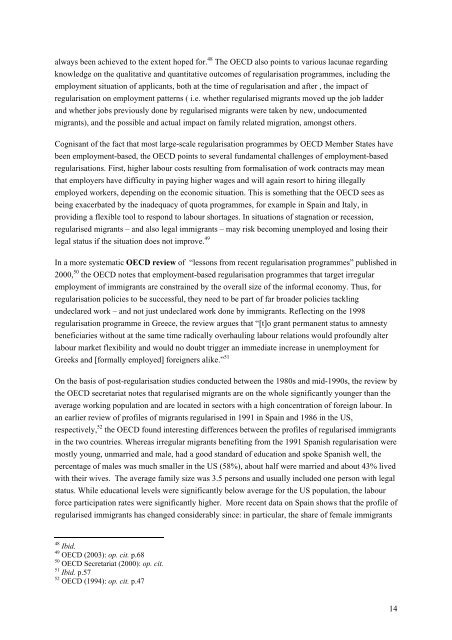REGINE Regularisations in Europe Final Report - European ...
REGINE Regularisations in Europe Final Report - European ...
REGINE Regularisations in Europe Final Report - European ...
You also want an ePaper? Increase the reach of your titles
YUMPU automatically turns print PDFs into web optimized ePapers that Google loves.
always been achieved to the extent hoped for. 48 The OECD also po<strong>in</strong>ts to various lacunae regard<strong>in</strong>g<br />
knowledge on the qualitative and quantitative outcomes of regularisation programmes, <strong>in</strong>clud<strong>in</strong>g the<br />
employment situation of applicants, both at the time of regularisation and after , the impact of<br />
regularisation on employment patterns ( i.e. whether regularised migrants moved up the job ladder<br />
and whether jobs previously done by regularised migrants were taken by new, undocumented<br />
migrants), and the possible and actual impact on family related migration, amongst others.<br />
Cognisant of the fact that most large-scale regularisation programmes by OECD Member States have<br />
been employment-based, the OECD po<strong>in</strong>ts to several fundamental challenges of employment-based<br />
regularisations. First, higher labour costs result<strong>in</strong>g from formalisation of work contracts may mean<br />
that employers have difficulty <strong>in</strong> pay<strong>in</strong>g higher wages and will aga<strong>in</strong> resort to hir<strong>in</strong>g illegally<br />
employed workers, depend<strong>in</strong>g on the economic situation. This is someth<strong>in</strong>g that the OECD sees as<br />
be<strong>in</strong>g exacerbated by the <strong>in</strong>adequacy of quota programmes, for example <strong>in</strong> Spa<strong>in</strong> and Italy, <strong>in</strong><br />
provid<strong>in</strong>g a flexible tool to respond to labour shortages. In situations of stagnation or recession,<br />
regularised migrants – and also legal immigrants – may risk becom<strong>in</strong>g unemployed and los<strong>in</strong>g their<br />
legal status if the situation does not improve. 49<br />
In a more systematic OECD review of “lessons from recent regularisation programmes” published <strong>in</strong><br />
2000, 50 the OECD notes that employment-based regularisation programmes that target irregular<br />
employment of immigrants are constra<strong>in</strong>ed by the overall size of the <strong>in</strong>formal economy. Thus, for<br />
regularisation policies to be successful, they need to be part of far broader policies tackl<strong>in</strong>g<br />
undeclared work – and not just undeclared work done by immigrants. Reflect<strong>in</strong>g on the 1998<br />
regularisation programme <strong>in</strong> Greece, the review argues that “[t]o grant permanent status to amnesty<br />
beneficiaries without at the same time radically overhaul<strong>in</strong>g labour relations would profoundly alter<br />
labour market flexibility and would no doubt trigger an immediate <strong>in</strong>crease <strong>in</strong> unemployment for<br />
Greeks and [formally employed] foreigners alike.” 51<br />
On the basis of post-regularisation studies conducted between the 1980s and mid-1990s, the review by<br />
the OECD secretariat notes that regularised migrants are on the whole significantly younger than the<br />
average work<strong>in</strong>g population and are located <strong>in</strong> sectors with a high concentration of foreign labour. In<br />
an earlier review of profiles of migrants regularised <strong>in</strong> 1991 <strong>in</strong> Spa<strong>in</strong> and 1986 <strong>in</strong> the US,<br />
respectively, 52 the OECD found <strong>in</strong>terest<strong>in</strong>g differences between the profiles of regularised immigrants<br />
<strong>in</strong> the two countries. Whereas irregular migrants benefit<strong>in</strong>g from the 1991 Spanish regularisation were<br />
mostly young, unmarried and male, had a good standard of education and spoke Spanish well, the<br />
percentage of males was much smaller <strong>in</strong> the US (58%), about half were married and about 43% lived<br />
with their wives. The average family size was 3.5 persons and usually <strong>in</strong>cluded one person with legal<br />
status. While educational levels were significantly below average for the US population, the labour<br />
force participation rates were significantly higher. More recent data on Spa<strong>in</strong> shows that the profile of<br />
regularised immigrants has changed considerably s<strong>in</strong>ce: <strong>in</strong> particular, the share of female immigrants<br />
48 Ibid.<br />
49 OECD (2003): op. cit. p.68<br />
50 OECD Secretariat (2000): op. cit.<br />
51 Ibid. p.57<br />
52 OECD (1994): op. cit. p.47<br />
14
















